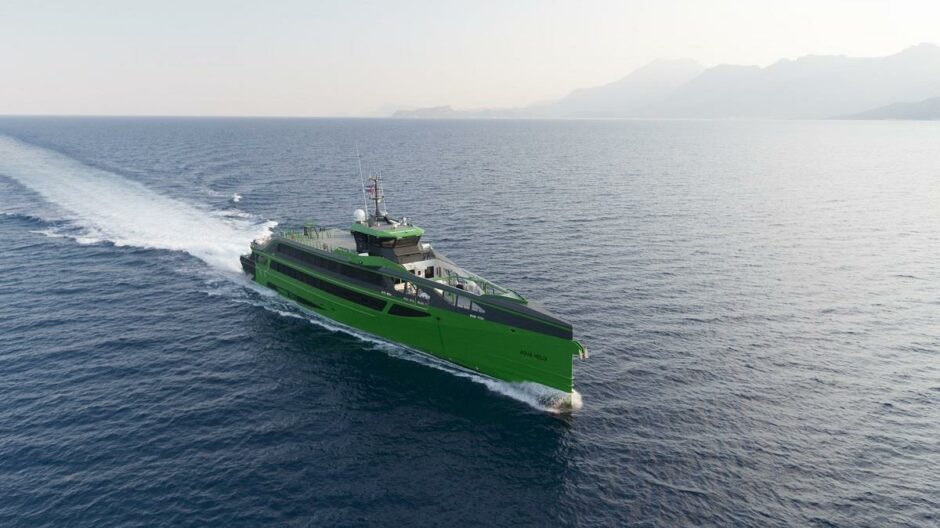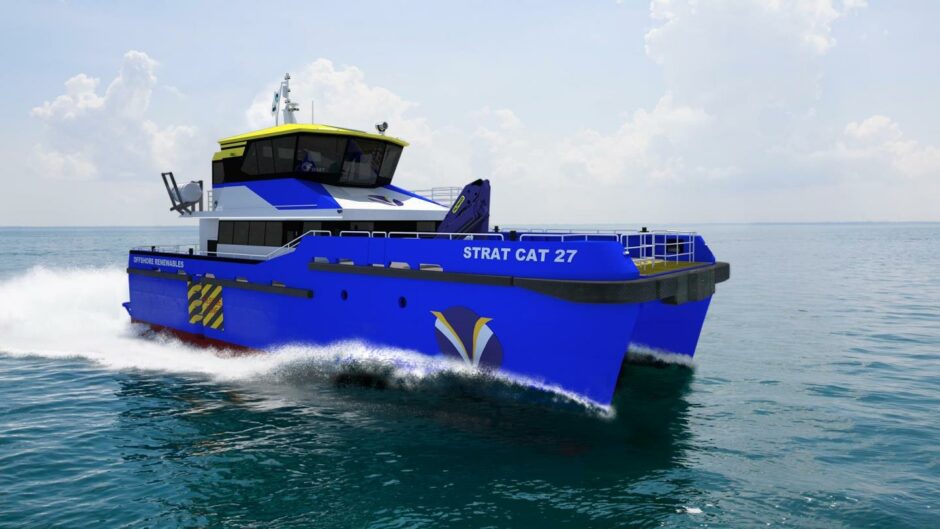
After five years of market consultation, research, design, engineering and construction, the first of Damen’s ground-breaking Fast Crew Supplier (FCS) 7011 class has completed its sea trials off the Turkish coast and should by now be en-route to The Netherlands.
The stylish, uber-sharp, 74-metre, 40 knot, 122-passenger, crew change vessel is very much aimed at the crew-change market though it would come as no surprise if, in a few years, it turns up on premium, express short-sea ferry routes in Europe especially.
Damen’s FCS 7011 model draws on experience with its dramatic, versatile and successful Sea Axe bow design and marries a now proven hull with the latest Ampelmann walk-to-work system.
Damen claims the vessel will offer a viable alternative to helicopter transport and has already gained substantial interest from clients in the southern North Sea, the Gulf of Mexico, Brazil and West Africa.
The primary market target is the now burgeoning offshore wind market, which is now a major player in the North Sea and which is poised to take off in other parts of the world.
But there will likely be a significant demand from the oil & gas industry in tropical regions, hence Brazil and West Africa.
One of Damen’s claims is that the not-so-snappily named FCS 7011’s business case is based on its ability to transfer much larger numbers of personnel for longer distances at higher speeds.
“This opens the door to moving away from day-rate structures towards a pay per journey model and, potentially, vessel sharing, whereby multiple offshore installations can be served in a single round trip, thereby delivering substantial savings in both time and operational costs,” says the company.
With journey times of up to 12 hours, comfort and safety are key. To achieve this the design incorporates the Damen Sea Axe bow, positioning of the accommodation just aft of amidships, and interceptors fitted within the vessel’s stern, all to minimise sensations of motion when under way.
The design, which is being jointly commercialised by Damen and Ampelmann, also incorporates a suite of motion-compensating technologies to optimise the safety of crew transfers.
Proof of concept trials will take place in the North Sea.
Six plus six Strat Cats placed on order
Meanwhile, in Asia-Pac, Singapore-based Sam Pan Marine Holdings has ordered six Strat Cat 27 (SC27) crew transfer boats from Strategic Marine (S) Pte, also of Singapore, with an option to build and deliver six more vessels.
Sam Pan Marine Holdings has also appointed Strategic Marine as the exclusive commercial agent to provide commercial management services for the vessels, including for bareboat charter or sale.
The boats are due for delivered from Q2 next year and will feature a mix of hybrid and hybrid-ready propulsion systems. Designed service speed is up to 30 knots.
Target market for the SC27 is offshore wind. It is being built in conjunction with the naval designer BMT. UK-headquartered, it has around 1,500 professionals located in 47 offices in the Americas, Asia, Australia, and Europe.
Crossing to the US…
Gladding-Hearn Shipbuilding/Duclos Corp. has signed an agreement to build an environmentally responsible multi-hull for US offshore wind company Mayflower Wind.
The vessel will be a hybrid, featuring both diesel and batter-based propulsion. It is understood that the order will be confirmed should Mayflower be awarded a contract under the latest State of Massachusetts procurement round for offshore wind.
Mayflower hopes to build a 2-gigawatt wind farm on the US Atlantic Outer Continental Shelf, about 30 miles south of Martha’s Vineyard, 20 miles south of Nantucket.
The offshore wind farm is expected to generate about 2,000 megawatts of electricity, according to information from the Mayflower Wind website. It expects the turbines to be spinning and generating power by the middle of this decade.
As for the boat, Gladding-Hearn is developing the design with an international grouping of marine specialists, namely Incat Crowther, BAR Technologies, Corvus Energy and ABS.
Design-work should start in the new year with a view to having a completed vessel ready for around 2025.
“Mayflower Wind aims to develop the most innovative, fuel-efficient CTV built in the United States,” said Michael Brown, CEO of Mayflower Wind.
“Ensuring that this vessel is constructed at a shipyard in Somerset is a big boost to the Massachusetts maritime economy and launches this shipyard toward a new and growing market.”
There is an obligation to build locally in the US because of the so-called Jones Act, an old piece of cabotage law that is rigorously enforced when it comes to offshore service vessels.
Meanwhile, in the UK…
Not to be outdone in the future tech offshore crew transfer boat market, British firm Ad Hoc Marine Designs Ltd (AHMD) has unveiled a new design that will be 100% battery-powered, based in-field aboard a mother vessel equipped for on-board charging.
The 15-m Faraday class is to be built by specialist vessel builder AMC on the Isle of Wight.
HMD/AMC are members of a consortium that last year secured a clean marine Department of Transport Grant.
Other members of that consortium are MJR Power, Turbulent Marine Simulations, Stirling Batteries and the ORE Catapult located in Glasgow.
AHMD has gone on record as saying that existing concepts for fast CTVs transporting wind turbine technicians from port to a windfarm are “being stretched to the limit” by far-from-shore windfarms. It claims that existing designs are not sustainable when using diesel engines.
The Faraday-class ePTV is designed to be carried in davits aboard motherships for infield deployment. Overnight, batteries are variously charged and/or replaced.
When working infield, it will also be possible for a Faraday boat to pick up additional battery charge directly from a wind turbine or return to its docking station at the mothership’s stern.
ANMD also intends that the new class can act as a benchmark for others to follow and that its battery system can be retrofitted to existing boats.
Recommended for you

 © Supplied by Strategic Marine
© Supplied by Strategic Marine